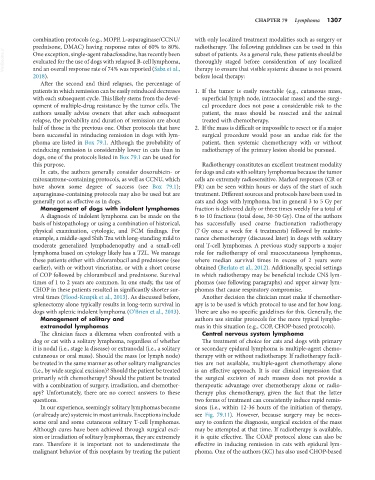Page 1335 - Small Animal Internal Medicine, 6th Edition
P. 1335
CHAPTER 79 Lymphoma 1307
combination protocols (e.g., MOPP, L-asparaginase/CCNU/ with only localized treatment modalities such as surgery or
prednisone, DMAC) having response rates of 60% to 80%. radiotherapy. The following guidelines can be used in this
VetBooks.ir One exception, single-agent rabacfosadine, has recently been subset of patients. As a general rule, these patients should be
thoroughly staged before consideration of any localized
evaluated for the use of dogs with relapsed B-cell lymphoma,
and an overall response rate of 74% was reported (Saba et al.,
before local therapy:
2018). therapy to ensure that visible systemic disease is not present
After the second and third relapses, the percentage of
patients in which remission can be easily reinduced decreases 1. If the tumor is easily resectable (e.g., cutaneous mass,
with each subsequent cycle. This likely stems from the devel- superficial lymph node, intraocular mass) and the surgi-
opment of multiple-drug resistance by the tumor cells. The cal procedure does not pose a considerable risk to the
authors usually advise owners that after each subsequent patient, the mass should be resected and the animal
relapse, the probability and duration of remission are about treated with chemotherapy.
half of those in the previous one. Other protocols that have 2. If the mass is difficult or impossible to resect or if a major
been successful in reinducing remission in dogs with lym- surgical procedure would pose an undue risk for the
phoma are listed in Box 79.1. Although the probability of patient, then systemic chemotherapy with or without
reinducing remission is considerably lower in cats than in radiotherapy of the primary lesion should be pursued.
dogs, one of the protocols listed in Box 79.1 can be used for
this purpose. Radiotherapy constitutes an excellent treatment modality
In cats, the authors generally consider doxorubicin- or for dogs and cats with solitary lymphomas because the tumor
mitoxantrone-containing protocols, as well as CCNU, which cells are extremely radiosensitive. Marked responses (CR or
have shown some degree of success (see Box 79.1); PR) can be seen within hours or days of the start of such
asparaginase-containing protocols may also be used but are treatment. Different sources and protocols have been used in
generally not as effective as in dogs. cats and dogs with lymphoma, but in general 3 to 5 Gy per
Management of dogs with indolent lymphomas fraction is delivered daily or three times weekly for a total of
A diagnosis of indolent lymphoma can be made on the 6 to 10 fractions (total dose, 30-50 Gy). One of the authors
basis of histopathology or using a combination of historical, has successfully used coarse fractionation radiotherapy
physical examination, cytologic, and FCM findings. For (7 Gy once a week for 4 treatments) followed by mainte-
example, a middle-aged Shih Tzu with long-standing mild to nance chemotherapy (discussed later) in dogs with solitary
moderate generalized lymphadenopathy and a small-cell oral T-cell lymphomas. A previous study supports a major
lymphoma based on cytology likely has a TZL. We manage role for radiotherapy of oral mucocutaneous lymphomas,
these patients either with chlorambucil and prednisone (see where median survival times in excess of 2 years were
earlier), with or without vincristine, or with a short course obtained (Berlato et al., 2012). Additionally, special settings
of COP followed by chlorambucil and prednisone. Survival in which radiotherapy may be beneficial include CNS lym-
times of 1 to 2 years are common. In one study, the use of phomas (see following paragraphs) and upper airway lym-
CHOP in these patients resulted in significantly shorter sur- phomas that cause respiratory compromise.
vival times (Flood-Knapik et al., 2013). As discussed before, Another decision the clinician must make if chemother-
splenectomy alone typically results in long-term survival in apy is to be used is which protocol to use and for how long.
dogs with splenic indolent lymphoma (O’Brien et al., 2013). There are also no specific guidelines for this. Generally, the
Management of solitary and authors use similar protocols for the more typical lympho-
extranodal lymphomas mas in this situation (e.g., COP, CHOP-based protocols).
The clinician faces a dilemma when confronted with a Central nervous system lymphoma
dog or cat with a solitary lymphoma, regardless of whether The treatment of choice for cats and dogs with primary
it is nodal (i.e., stage Ia disease) or extranodal (i.e., a solitary or secondary epidural lymphoma is multiple-agent chemo-
cutaneous or oral mass). Should the mass (or lymph node) therapy with or without radiotherapy. If radiotherapy facili-
be treated in the same manner as other solitary malignancies ties are not available, multiple-agent chemotherapy alone
(i.e., by wide surgical excision)? Should the patient be treated is an effective approach. It is our clinical impression that
primarily with chemotherapy? Should the patient be treated the surgical excision of such masses does not provide a
with a combination of surgery, irradiation, and chemother- therapeutic advantage over chemotherapy alone or radio-
apy? Unfortunately, there are no correct answers to these therapy plus chemotherapy, given the fact that the latter
questions. two forms of treatment can consistently induce rapid remis-
In our experience, seemingly solitary lymphomas become sions (i.e., within 12-36 hours of the initiation of therapy,
(or already are) systemic in most animals. Exceptions include see Fig. 79.11). However, because surgery may be neces-
some oral and some cutaneous solitary T-cell lymphomas. sary to confirm the diagnosis, surgical excision of the mass
Although cures have been achieved through surgical exci- may be attempted at that time. If radiotherapy is available,
sion or irradiation of solitary lymphomas, they are extremely it is quite effective. The COAP protocol alone can also be
rare. Therefore it is important not to underestimate the effective in inducing remission in cats with epidural lym-
malignant behavior of this neoplasm by treating the patient phoma. One of the authors (KC) has also used CHOP-based

